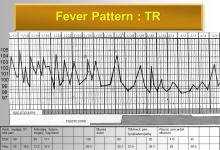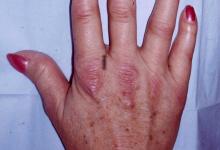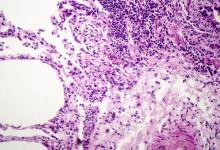ERS/EULAR guidelines for CTD-related interstitial lung disease Save

The European Respiratory Society (ERS) and European Alliance of Associations for Rheumatology (EULAR) have published clinical practice guidelines for the evaluation and management of connective tissue diseases (CTD) associated interstitial lung disease (ILD) in two simultaneous publications in the European Respiratory Journal and Annals of Rheumatic Diseases.
A multidisciplinary task force (pulmonologists, rheumatologists, pathologists, radiologists, methodologists and patients) developed recommendations based on specific PICO questions and GRADE methodology to grade the evidence. Ultimately these recommendations and management algorithms (for each CTD) are based on evidence, consensus and usual clinical practice. ILD in association with CTD included systemic sclerosis (SSc), idiopathic inflammatory myopathies (IIM), Sjögren disease (SjD), systemic lupus erythematosus (SLE), mixed CTD (MCTD), and rheumatoid arthritis (RA). The occurrence of ILD in these CTDs imparts high morbidity and mortality.
From 5 PICO and 10 narrative questions, 50 disease-specific recommendations were published.
Overall, these guidelines recommend screening all patients with SSc, MCTD, and IIM (but not people with inclusion body myositis); and only screening in RA and SjD who have risk factors for ILD.
The recommended screening tool is high-resolution computed tomography (HRCT). Lung biopsy should only be considered if alternative diagnoses are possible. At the time of ILD diagnosis, all patients should be assessed for severity, trajectory/ progression, and functional ability.
They recommend assessments with lung function tests, HRCT scans, 6-minute walking test, and patient-reported outcome measures. High-risk patients may need to be assessed more frequently with lung function tests, HRCT, and PROMs.
Choice of therapy is guided by CTD diagnosis, extrapulmonary manifestations, and the risk of progressive or severe ILD. Those with progressive or severe ILD need early and aggressive treatment.
The authors recognized the new guideline has some limitations and builds on evidence of low certainty.
Select Recommendations:
- We suggest performing a global assessment of all risk factors of ILD progression in patients with SSc, RA and IIM to identify patients at higher risk of ILD progression and death.
- We suggest that patients with RA and risk factors for ILD (older age, smoking history, elevated RF, anti-CCP antibodies, increased inflammatory markers, male sex and high articular disease activity) could be screened for ILD using HRCT
- We recommend that patients with IIM and risk factors (anti-synthetase syndrome, clinically amyopathic dermatomyositis, presence of mechanic's hands, arthritis and certain myositis-associated autoantibodies (anti-synthetase, anti-MDA-5 and anti-Ro52 antibodies), should be screened for ILD using HRCT
- We suggest that most patients with IIM without risk factors could be screened for ILD using HRCT, except patients with inclusion body myositis
- We suggest that BAL could be used in patients with any CTD-ILD at the time of diagnosis in cases where there is suspicion of infection or to exclude alternative diagnoses. We suggest that lung biopsy should not play a role for diagnosis.
- We suggest using the 6MWT in patients without physical limitations and PROMs to assess severity and/or prognosis of ILD in any CTD-ILD patients.
- We suggest repeating PFTs every 3–6 months during the first years, and at least every 6–12 months thereafter. We suggest regularly repeating HRCT after 1–2 years in patients with SSc-ILD, RA-ILD and other CTD-ILD, and after 3–6 months in IIM-ILD, particularly in those at higher risk of progression. We suggest repeating PFTs and HRCT in case of suspected progression in any CTD-ILD patient.
Treatment Recommendations:
- We suggest using MMF in patients with SSc-ILD
- We recommend using tocilizumab in SSc-ILD patients with early diffuse cutaneous SSc and increased inflammatory markers or recent skin fibrosis progression
- We suggest using rituximab in patients with SSc-ILD
- We suggest using cyclophosphamide in patients with SSc-ILD
- We recommend using immunosuppressive treatment in patients with IIM-ILD
- We suggest using immunosuppressive treatment in patients with RA-, SjD-, MCTD- and SLE-ILD
- We suggest using nintedanib in SSc-ILD and in any CTD-ILD patient with progressive pulmonary fibrosis.
- We suggest using pirfenidone in patients with RA-ILD with a UIP pattern
- We suggest using combination therapy with nintedanib and MMF in patients with SSc-ILD
- We suggest using combination therapy with immunosuppressants including glucocorticoids in patients with IIM-ILD
- We suggest treating patients with any CTD-ILD with a combination of immunosuppressants or, in the presence of progressive pulmonary fibrosis, with a combination of an immunosuppressant and nintedanib
Sources
Antonio K, et al. ERS/EULAR clinical practice guidelines for connective tissue diseases associated interstitial lung disease. Eur Resp J 2025; doi.org/10.1183/13993003.02533-2024
Antonio K, et al. ERS/EULAR clinical practice guidelines for connective tissue diseases associated interstitial lung disease. Ann Rheum Dis 2025; doi.org/10.1016/j.ard.2025.08.009










If you are a health practitioner, you may Login/Register to comment.
Due to the nature of these comment forums, only health practitioners are allowed to comment at this time.